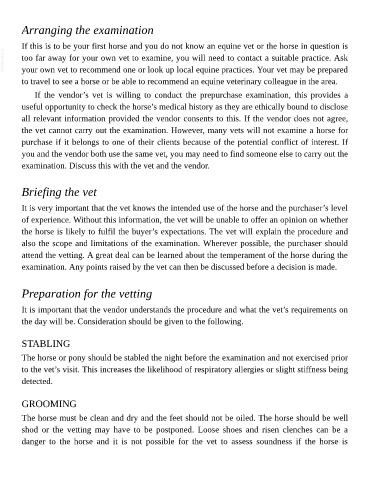Page 1057 - The Veterinary Care of the Horse
P. 1057
Arranging the examination
If this is to be your first horse and you do not know an equine vet or the horse in question is
VetBooks.ir too far away for your own vet to examine, you will need to contact a suitable practice. Ask
your own vet to recommend one or look up local equine practices. Your vet may be prepared
to travel to see a horse or be able to recommend an equine veterinary colleague in the area.
If the vendor’s vet is willing to conduct the prepurchase examination, this provides a
useful opportunity to check the horse’s medical history as they are ethically bound to disclose
all relevant information provided the vendor consents to this. If the vendor does not agree,
the vet cannot carry out the examination. However, many vets will not examine a horse for
purchase if it belongs to one of their clients because of the potential conflict of interest. If
you and the vendor both use the same vet, you may need to find someone else to carry out the
examination. Discuss this with the vet and the vendor.
Briefing the vet
It is very important that the vet knows the intended use of the horse and the purchaser’s level
of experience. Without this information, the vet will be unable to offer an opinion on whether
the horse is likely to fulfil the buyer’s expectations. The vet will explain the procedure and
also the scope and limitations of the examination. Wherever possible, the purchaser should
attend the vetting. A great deal can be learned about the temperament of the horse during the
examination. Any points raised by the vet can then be discussed before a decision is made.
Preparation for the vetting
It is important that the vendor understands the procedure and what the vet’s requirements on
the day will be. Consideration should be given to the following.
STABLING
The horse or pony should be stabled the night before the examination and not exercised prior
to the vet’s visit. This increases the likelihood of respiratory allergies or slight stiffness being
detected.
GROOMING
The horse must be clean and dry and the feet should not be oiled. The horse should be well
shod or the vetting may have to be postponed. Loose shoes and risen clenches can be a
danger to the horse and it is not possible for the vet to assess soundness if the horse is

